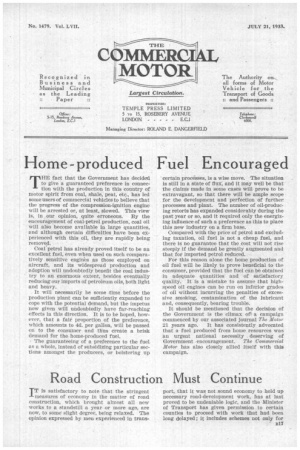Ro'ad Construction Must Continue
Page 31

Page 32

If you've noticed an error in this article please click here to report it so we can fix it.
TT is satisfactory to note that the stringent -I-measures of economy in the matter of road construction, which brought almost all new works to a standstill a year or more ago, are now, to some slight degree, being relaxed. The opinion expressed by men experienced in trans port, that it was not .sound economy to hold up necessary road-development work, has at last proved to be undeniable logic, and the Minister of Transport has given permission to certain counties to proceed with work that had been long delayed; it includes schemes not only for construction but also for the building of badly needed bridges.
The point is that the work has to be done sooner or later. The schemes would not have been decided upon in the first place had they not appealed to the authorities as being necessary in the commercial and general interests of the country. Despite the efforts of antagonistic interests to hamper the use of the roads, road transport must go on if industry is to thrive, and justifiable road improvements mean reduced transport costs, increased safety (for example, where populated areas are bypassed), and, of course, the employment of labour and circulation of money.
These aspects of the situation, there is no doubt, were not given the consideration which their importance warranted, and the subsequent realization that excessive zeal in the limitation of progress might prove a false economy was only to be expected.
Within reasonable limits, the same attitude should be adopted in the matter of the development of municipal aerodromes. These are urgently needed, and any reluctance on the part Of important towns to proceed with aerodromes will cause considerable embarrassment within a very few years. Such schemes must embrace plans for rapid transport connections between the aerodrome sites chosen and the centres of the towns they will serve.
Should Engine and Gearbox be Divorced ?
rp HERE is a tendency amongst commercial-1vehicle designers to revert to the separateunit system of construction for the engine and gearbox. For some years past, the tendency has been in the other direction, mainly to facilitate manufacture, possibly, also, because enbloc construction reduces the number of universal joints, but the latter components are now so reliable that this point is no longer a matter of any great consequence.
If users be consulted it will generally be found that the majority greatly favours a separate gearbox, partly because of the enhanced accessibility to engine, clutch and gearbox, and partly because the weight is split up and the individual units are not so cumbersome.
It is probable that en-bloc construction will still continue to be used for the majority of the lighter classes of chassis where the weight factor is not so important, and where maintenance is so often effected by the exchange of the complete unit.
Where the engine is very flexibly supported, It must also be remembered that the weight of the gearbox attached to it increases the effect of the unbalanced forces, and the solid connection between them helps to transmit vibrations to the rest of the chassis.




























































































